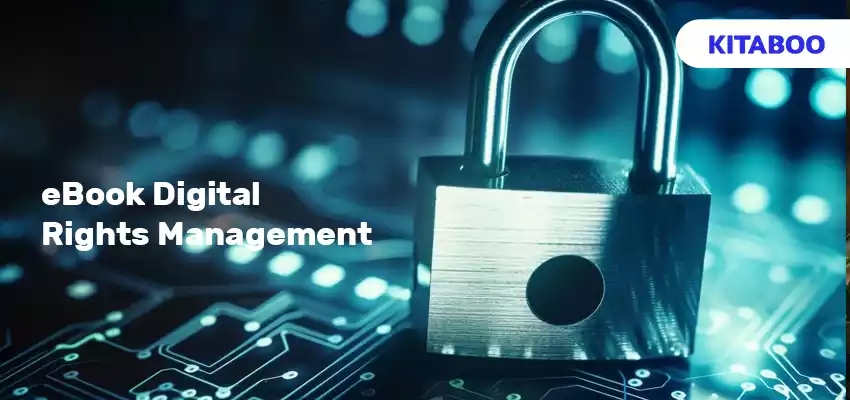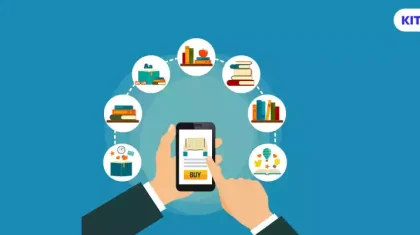
Revolutionize Your eBook Security with DRM Systems
Summarize this blog with your favorite AI:
One of the key challenges that industries and businesses face when dealing with digital content is the unauthorized use of their copyright.
eBook Digital Rights Management is a solution that revolves around a systematic approach to protect copyrights, prevent unauthorized use and redistribution of digital content, and regulate consumer access to purchased content.
The surge in online piracy is a growing concern; however, there are unique and integrated technologies that inhibit the copying of content. Such solutions impose access timeframes and restrict the number of devices for content use and installation.
Digital Rights Management (DRM) empowers content creators, paves the way for higher monetization capabilities, and mitigates legal risks arising from unauthorized digital content usage.
Leading digital textbook platforms like KITABOO, which incorporate DRM systems, play a pivotal role in data security. Data security has become the need of the hour, considering the growth in piracy, illicit distribution of content, and misuse of intellectual property.
Here is an overview of the essence, scope, challenges, solutions, and benefits revolving around the use of digital rights management in digital publishing.
Table of Contents:
I. Common Challenges Faced by Content Owners in the Absence of DRM Systems
II. Meaning and Essence of eBook Digital Rights Management
III. Operational Capabilities and Functions of eBook Digital Rights Management
IV. Use Cases of Digital Rights Management Systems
- Content Protection
- Data Access Control
- Preservation of Integrity
- Intellectual Property Protection
- Industry Use-Cases
V. Conclusion
Common Challenges Faced by Content Owners in the Absence of DRM Systems
When handling user data or sensitive information, content creators, publishers, or owners can face several challenges or obstacles related to compliance with data security and privacy regulations. Such activities can eventually result in fines or other penalties in the future.
Traditional content publishing methodologies can pose certain challenges.
- Unauthorized content access poses risks to confidentiality and integrity.
- Revenue loss or income damage for publishers..
- Intellectual property ownership risks from unauthorized content use or access.
- Difficulty in clearly defining copyright and ownership parameters leads to misuse or infringement issues.
Meaning and Essence of eBook Digital Rights Management
eBook Digital Rights Management is a system that utilizes various encryption methods to impose restrictions on your eBooks. The primary objective of this system is to combat online piracy and prevent unauthorized file-sharing.
Instead of targeting individuals engaged in piracy, DRM focuses on preventing the unauthorized stealing or sharing of content from occurring in the first place. It is important to understand the essence of integrating DRM mechanisms in your content creation and digital publishing strategy.
Failure to adhere to permissions and authorizations can result in legal lawsuits and penalties for the perpetrators. Introducing DRM mechanisms early on while working with digital content can protect content, streamline workflows, and offer proactive protection against potential infringements.
DRM software encompasses:
- An array of processes, policies, and technologies to regulate the usage and distribution of digital content owned by content creators.
- Relevant copyright laws to protect content owners and corporations involved in content creation and distribution across digital platforms.
- Methods to organize, store, retrieve, and share content within their allowed circle.
- Licenses defining the terms and duration of content usage.
Operational Capabilities and Functions of eBook Digital Rights Management
Let us look at key applications and techniques that can be incorporated using DRM:
- It can impose restrictions on accessing, printing, and copying materials based on the content creator’s directives.
- Holding massive relevance in multimedia-enriched data, it can limit access to the number of copies of videos/audio/text users can make.
- DRM involves coding to prevent copying or to limit access time or the number of devices permitted to access a particular product.
- It offers users a set number of permissible prints and can even restrict users from capturing screenshots.
- Further, when protecting your eBooks, it can set expiration dates for documents or media, restrict access to specific IP addresses, locations, or devices, and watermark multimedia or artworks.
- Furthermore, DRM-enriched software like KITABOO enables industries and organizations to access user data to regulate who uses the content and for how long.
- Although some view DRM software as excessively restrictive, it serves as a legitimate means to combat piracy.
- A mobile-DRM framework governs content usage on mobile devices and applies necessary protection mechanisms on mobile content services, content providers, service providers, and operators.
Use Cases of Digital Rights Management Systems
In today’s digital landscape, eBook Digital Rights Management is not only helpful for content creators but also extends to offering licensed digital assets to companies and individuals. Some of the common use cases and applications of digital rights management software are:
1. Content Protection
DRM empowers authors, musicians, filmmakers, and other creators to prevent unauthorized usage of their content, thus protecting their financial interests and controlling product distribution.
2. Data Access Control
Companies leverage DRM to manage access to confidential information, imposing restrictions on sensitive data while facilitating secure sharing. In business settings, especially in the healthcare and financial sectors, DRM helps in meeting data protection regulations and legal industry obligations.
3. Preservation of Integrity
DRM ensures the preservation of digital works in their original state, preventing a creators’ work from being disseminated with alterations.
4. Intellectual Property Protection
Industries such as education, manufacturing, technology, and biotech rely on DRM to safeguard patents, literature, libraries, videos, trademarks, audiobooks, customer data, and proprietary processes stored across various platforms.
5. Industry Use-Cases:
DRM is utilized across diverse industries:
- In the media & entertainment industry, it ensures compliance with copyright laws and preserves revenue streams.
- In the software & gaming world it maintains the integrity of licensed software or games, employing methods such as activation keys and online authentication.
- In publishing & education it is used to protect educational eBooks, scholarly articles, and other digital publications. Digital textbook platforms like KITABOO help facilitate the secure distribution of digital textbooks while ensuring copyright compliance.
- In the corporate world it serves to protect sensitive data by enforcing access restrictions, implementing features like watermarking, and controlling document permissions to prevent data breaches and unauthorized sharing.
- In the healthcare industry it protects sensitive medical records, patient history, and research data, ensuring privacy, confidentiality, and compliance with data privacy regulations.
Conclusion
Irrespective of the industry or organization you are in, creating content across various channels, audience segments, and customer needs is a priority.
All you need is an effective DRM system to help you deal with challenges in managing your digital assets.
Software applications and digital publishing platforms like KITABOO ensure compliance with content protection and intellectual property rights. Using eBook Digital Rights Management, such software helps protect digital content and simplifies content tracking and usage monitoring.
To get started with DRM, connect with us now!
Also Check:
Discover how a mobile-first training platform can help your organization.
KITABOO is a cloud-based platform to create, deliver & track mobile-first interactive training content.



